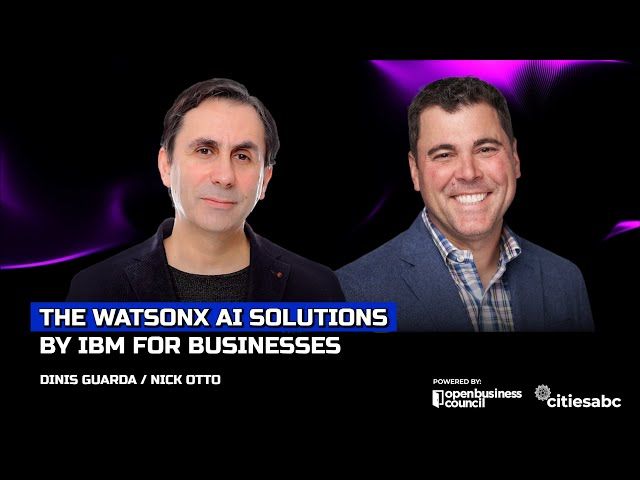Whether it’s predictive analytics for forecasting market trends, chatbots for improving customer interactions, or automation for repetitive tasks, AI is a catalyst for innovation in enterprises. Nick Otto, Head of Global Strategic Partnerships at IBM, explains the Watsonx solutions that the company has created for its partners and clients in the recent interview with Dinis Guarda.

AI technologies, such as machine learning and natural language processing, empower enterprises to analyse vast amounts of data swiftly, extract meaningful insights, and automate complex tasks. From enhancing customer experiences through chatbots and personalised recommendations to optimising supply chain management through predictive analytics, AI offers a broad spectrum of applications.
IBM has leveraged AI, creating tech solutions to streamline workflows, improve efficiency, and gain a competitive edge in an increasingly data-driven business landscape. During the interview, Nick also highlighted the use cases of their AI enabled solutions for predictive analytics, aiding in strategic decision-making and fostering innovation.
“We think that there is some value to come from open AI and some of the big models that are out there. However, there is a huge spectrum of use across a wide array of different types of companies. So, we want to make sure that we have the flexibility for our customers and partners to get access to the various capabilities – how do all the capabilities come together, and most importantly, how do we get value out of it”, he told Dinis.
The Watsonx AI solutions by IBM
Watsonx consists of three key components designed to empower businesses in tailoring their AI solutions: watsonx.ai, offering user-friendly tools for robust foundation models; watsonx.data, facilitating compute-efficient and scalable workloads across diverse data locations; and the third component, watsonx.governance, which establishes crucial guardrails for responsible implementation.
Organisations leveraging Watsonx gain the capability to enhance foundation models using their specific domain data, providing a competitive edge and ensuring accuracy by aligning with external knowledge sources. These features, coupled with a diverse array of traditional machine learning and AI functions, are now accessible to independent software vendors (ISVs) and managed service providers (MSPs) as integral components of IBM’s embeddable software portfolio. This offering is supported by the IBM Ecosystem Engineering Build Lab and the broader partner ecosystem, facilitating seamless integration and implementation.
Establishing a unique IBM AI
IBM’s Watsonx AI solutions, including Watsonx Assistant and watsonx.ai, empower companies to embed generative AI into their customer care portals. This facilitates quick and easy integration of AI, enabling companies to provide seamless customer experiences, summarising conversations, extracting key information, and conducting sentiment analysis to enhance customer satisfaction.
Watsonx plays a crucial role in streamlining procurement processes within enterprises. By leveraging Watsonx Assistant, watsonx.ai, and watsonx.data, organisational leaders can connect disparate processes and data, creating integrated end-to-end solutions. For instance, Watsonx Assistant serves as a user-friendly interface for supplier databases, generating queries and content, while Watsonx.data acts as a front end for ERP systems, providing up-to-date information for smarter decision-making.
Ubotica utilises IBM Cloud and watsonx.ai in its CogniSAT platform, enabling developers to deploy AI models to satellites for various observational use cases, such as detecting forest fires or space junk. CogniSAT enhances the efficiency of data storage and processing, providing edge-based analysis onboard satellites and showcasing the versatility of Watsonx in innovative applications beyond traditional business domains.
“Those are the use cases that we have are the ready to go assets to help people accelerate. But, a majority of work today is not in those ready to go assets. We are building new models with partners like SAP – how do we take these assets that we have and those that our partners have, and create unique things that can drive a joint value in the market.
The way we are driving our .ai from an open and hybrid perspective to be able to continue to evolve over that entire evolving market across our partners and clients needs is essential. As you have this incredibly complex environment, being able to make sure you understand where every insight is coming from, governance is so core to that.
We are going to continue to innovate more and more in that space”, says Nick.

Hernaldo Turrillo is a writer and author specialised in innovation, AI, DLT, SMEs, trading, investing and new trends in technology and business. He has been working for ztudium group since 2017. He is the editor of openbusinesscouncil.org, tradersdna.com, hedgethink.com, and writes regularly for intelligenthq.com, socialmediacouncil.eu. Hernaldo was born in Spain and finally settled in London, United Kingdom, after a few years of personal growth. Hernaldo finished his Journalism bachelor degree in the University of Seville, Spain, and began working as reporter in the newspaper, Europa Sur, writing about Politics and Society. He also worked as community manager and marketing advisor in Los Barrios, Spain. Innovation, technology, politics and economy are his main interests, with special focus on new trends and ethical projects. He enjoys finding himself getting lost in words, explaining what he understands from the world and helping others. Besides a journalist, he is also a thinker and proactive in digital transformation strategies. Knowledge and ideas have no limits.




























